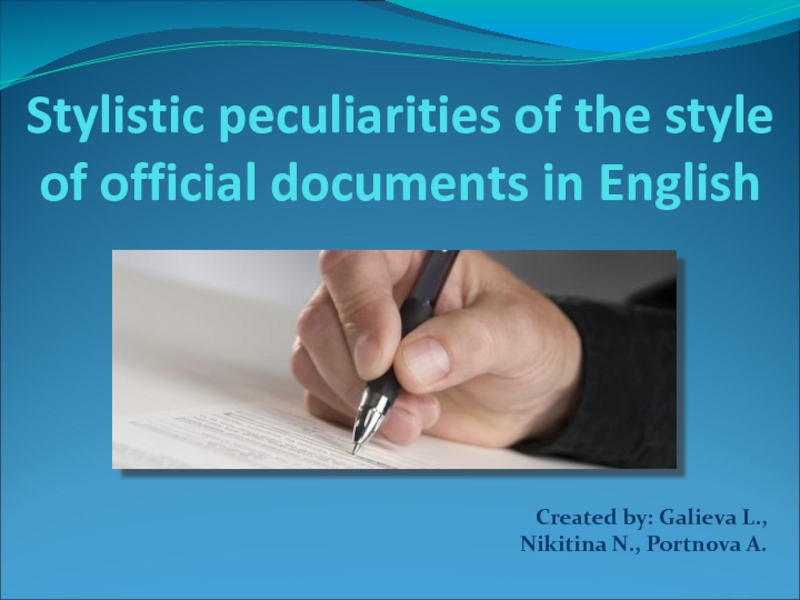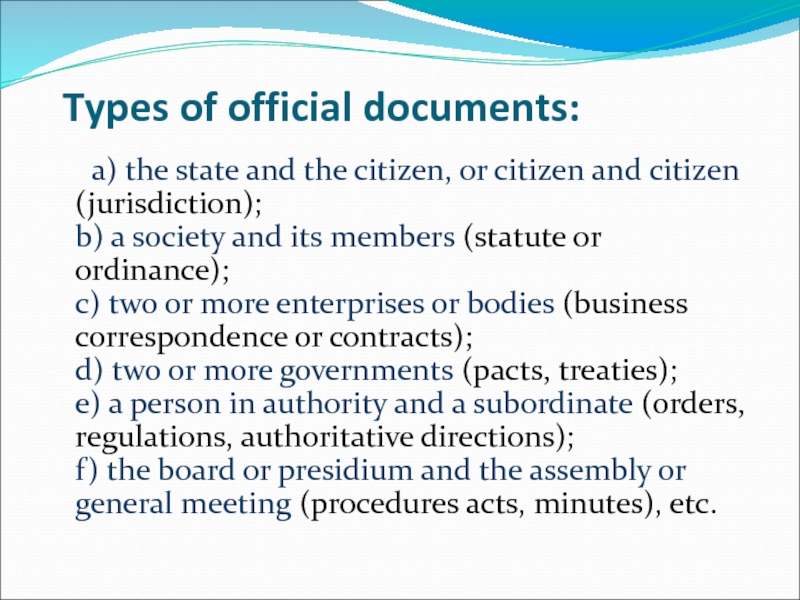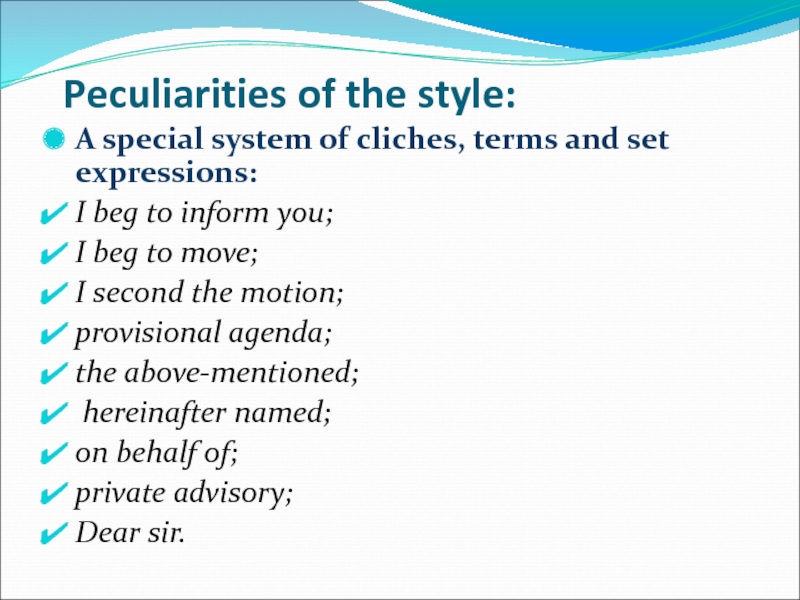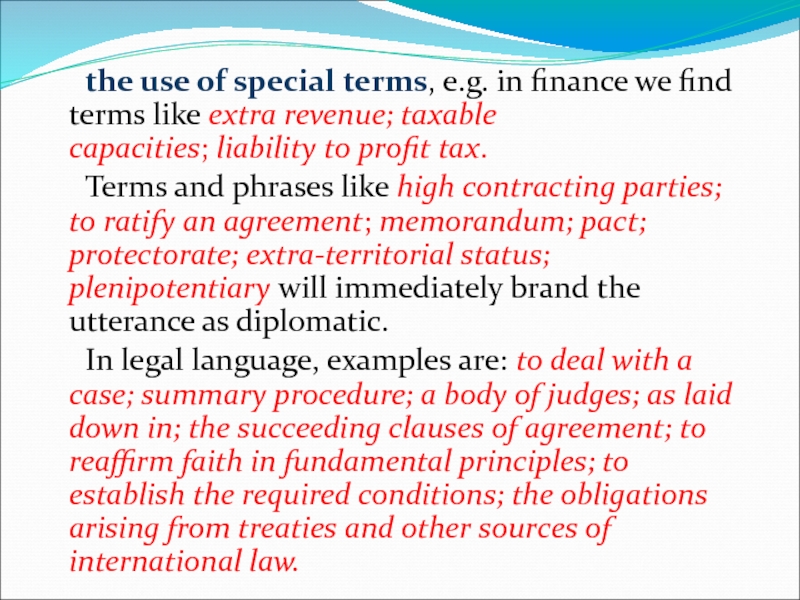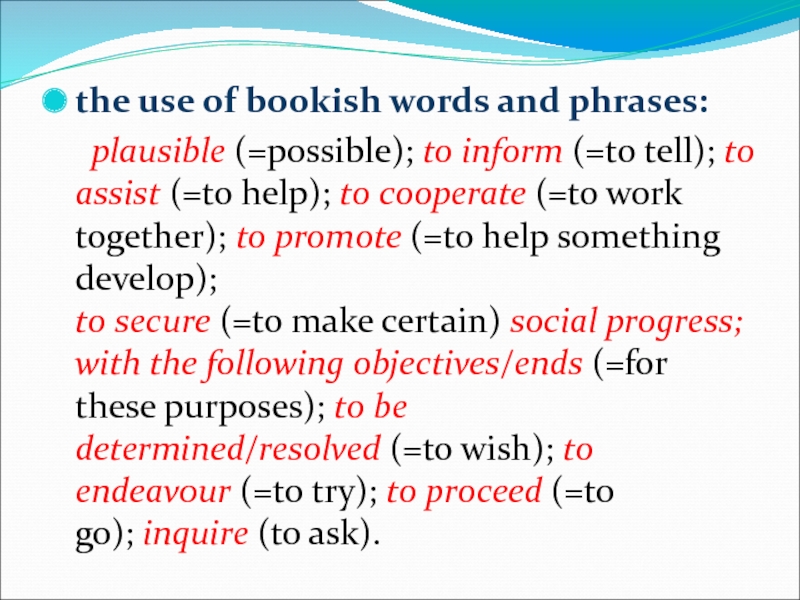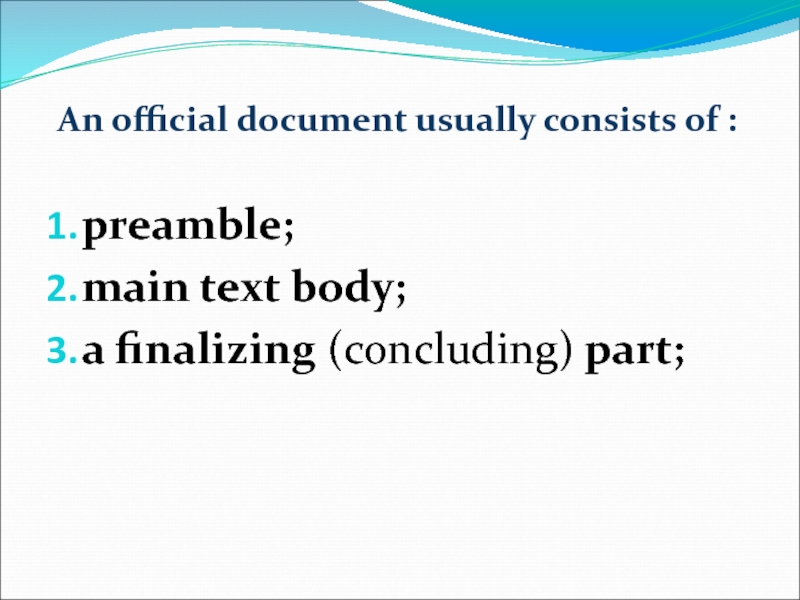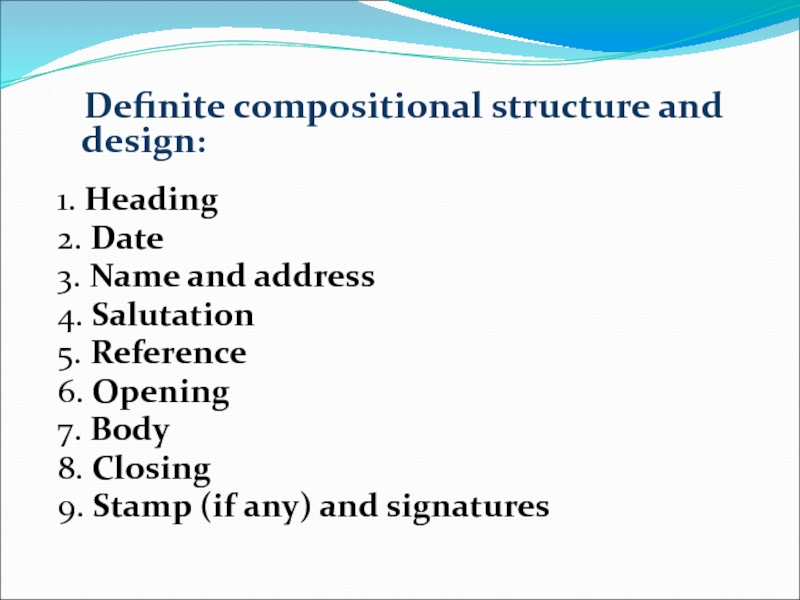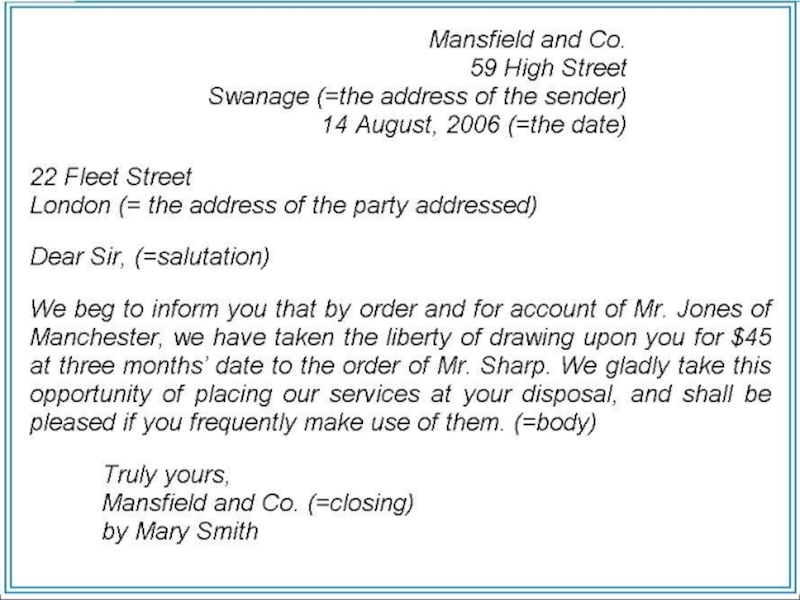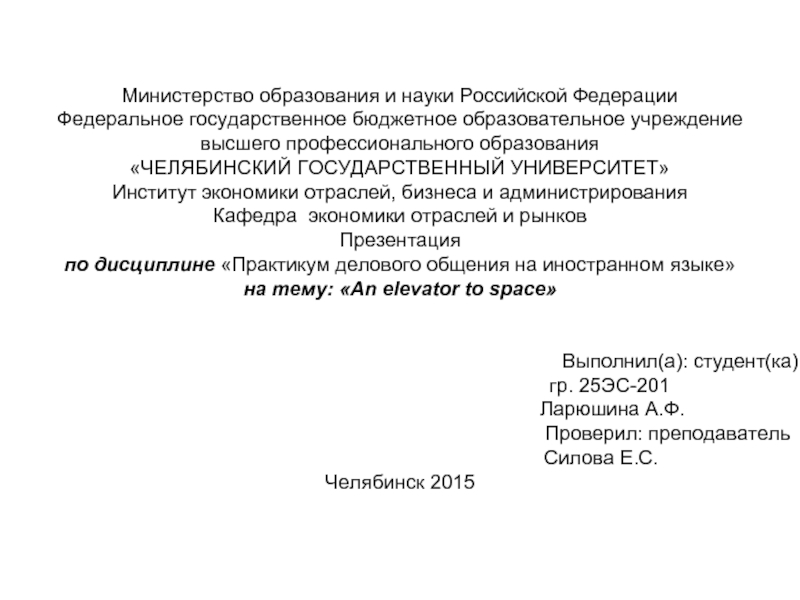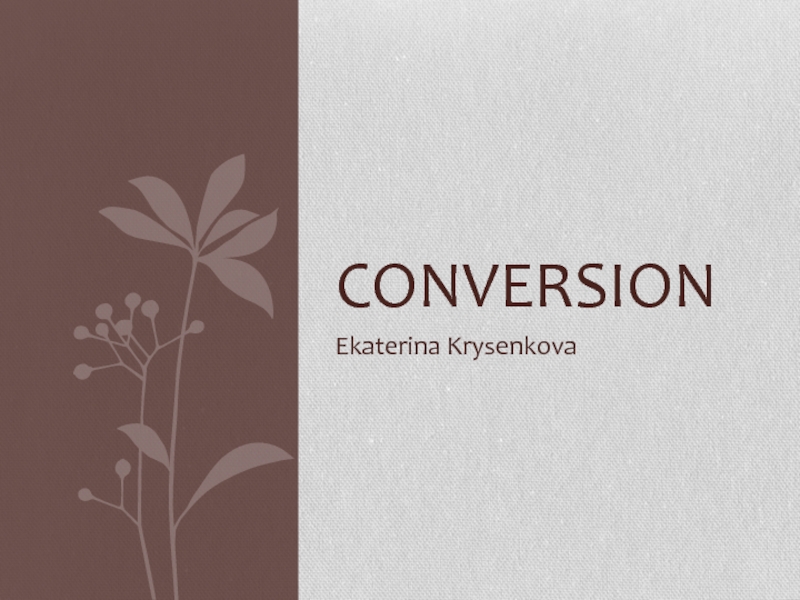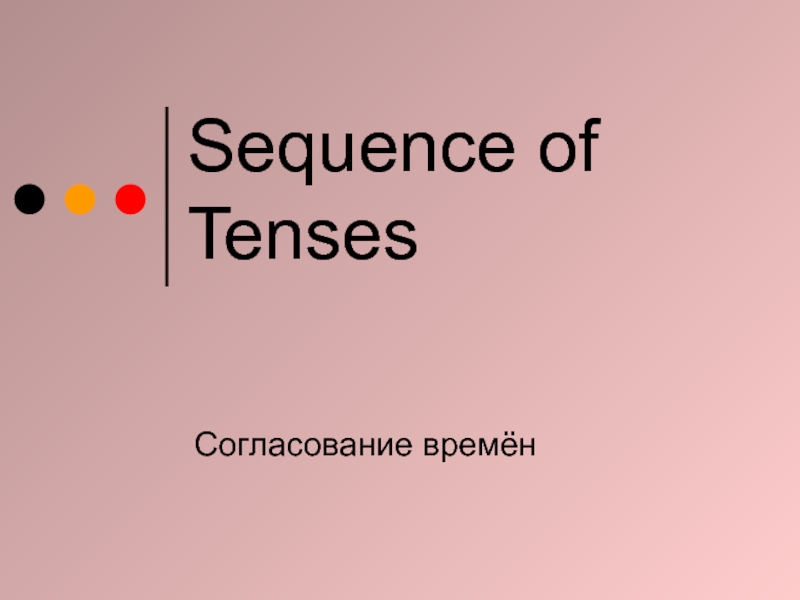Galieva L., Nikitina N., Portnova A.
- Главная
- Разное
- Дизайн
- Бизнес и предпринимательство
- Аналитика
- Образование
- Развлечения
- Красота и здоровье
- Финансы
- Государство
- Путешествия
- Спорт
- Недвижимость
- Армия
- Графика
- Культурология
- Еда и кулинария
- Лингвистика
- Английский язык
- Астрономия
- Алгебра
- Биология
- География
- Детские презентации
- Информатика
- История
- Литература
- Маркетинг
- Математика
- Медицина
- Менеджмент
- Музыка
- МХК
- Немецкий язык
- ОБЖ
- Обществознание
- Окружающий мир
- Педагогика
- Русский язык
- Технология
- Физика
- Философия
- Химия
- Шаблоны, картинки для презентаций
- Экология
- Экономика
- Юриспруденция
Stylistic peculiarities of the style of official documents in english презентация
Содержание
- 1. Stylistic peculiarities of the style of official documents in english
- 2. Official documents are written
- 3. a) the state and the citizen,
- 4. The aim of communication in this style
- 5. Peculiarities of the style: A special system
- 6. the use of abbreviations, conventional symbols
- 7. the use of special terms, e.g. in
- 8. the use of bookish words and phrases:
- 9. absence of emotiveness, except: Dear Sir; yours faithfully
- 10. An official document usually consists of
- 11. Definite compositional structure and
- 13. Thank you for your attention!
Слайд 2
Official documents are written in a formal, “cold” or
matter-of-fact style of speech.
The style of official documents is represented by the following sub-styles, or varieties:
the language of business documents
the language of legal documents
the language of diplomacy
the language of military documents
The style of official documents is represented by the following sub-styles, or varieties:
the language of business documents
the language of legal documents
the language of diplomacy
the language of military documents
Слайд 3
a) the state and the citizen, or citizen and citizen (jurisdiction);
b)
a society and its members (statute or ordinance);
c) two or more enterprises or bodies (business correspondence or contracts);
d) two or more governments (pacts, treaties);
e) a person in authority and a subordinate (orders, regulations, authoritative directions);
f) the board or presidium and the assembly or general meeting (procedures acts, minutes), etc.
Types of official documents:
Слайд 4 The aim of communication in this style of language is to
reach agreement between two contracting parties.
Слайд 5Peculiarities of the style:
A special system of cliches, terms and set
expressions:
I beg to inform you;
I beg to move;
I second the motion;
provisional agenda;
the above-mentioned;
hereinafter named;
on behalf of;
private advisory;
Dear sir.
I beg to inform you;
I beg to move;
I second the motion;
provisional agenda;
the above-mentioned;
hereinafter named;
on behalf of;
private advisory;
Dear sir.
Слайд 6
the use of abbreviations, conventional symbols and contractions, e. g.
MP
(Member of Parliament); Gvt. (government); H.M.S. (Her Majesty’s Steamship); $(dollar); Ltd (Limited).
DAO (Divisional Ammunition Officer); adv. (advance); atk. (attack); obj. (object); A/T (anti-tank); ATAS (Air Transport Auxiliary Service).
DAO (Divisional Ammunition Officer); adv. (advance); atk. (attack); obj. (object); A/T (anti-tank); ATAS (Air Transport Auxiliary Service).
Слайд 7 the use of special terms, e.g. in finance we find terms
like extra revenue; taxable capacities; liability to profit tax.
Terms and phrases like high contracting parties; to ratify an agreement; memorandum; pact; protectorate; extra-territorial status; plenipotentiary will immediately brand the utterance as diplomatic.
In legal language, examples are: to deal with a case; summary procedure; a body of judges; as laid down in; the succeeding clauses of agreement; to reaffirm faith in fundamental principles; to establish the required conditions; the obligations arising from treaties and other sources of international law.
Terms and phrases like high contracting parties; to ratify an agreement; memorandum; pact; protectorate; extra-territorial status; plenipotentiary will immediately brand the utterance as diplomatic.
In legal language, examples are: to deal with a case; summary procedure; a body of judges; as laid down in; the succeeding clauses of agreement; to reaffirm faith in fundamental principles; to establish the required conditions; the obligations arising from treaties and other sources of international law.
Слайд 8the use of bookish words and phrases:
plausible (=possible); to inform (=to tell); to assist (=to help); to
cooperate (=to work together); to promote (=to help something develop);
to secure (=to make certain) social progress; with the following objectives/ends (=for these purposes); to be determined/resolved (=to wish); to endeavour (=to try); to proceed (=to go); inquire (to ask).
Слайд 10
An official document usually consists of :
preamble;
main text body;
a finalizing (concluding) part;
Слайд 11
Definite compositional structure and design:
1. Heading
2. Date
3. Name and address
4. Salutation
5. Reference
6. Opening
7. Body
8. Closing
9. Stamp (if any)
and signatures
